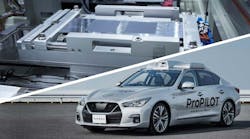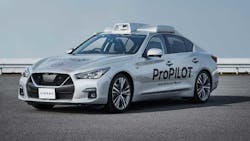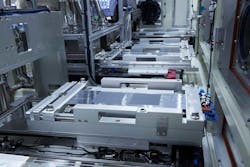This article is part of the TechXchange: EV Battery Management
What you'll learn:
- What is "ground truth perception"?
- Moving forward with advanced collision-avoidance-control technology.
- The latest on the company's efforts in developing cobalt-free all-solid-state batteries.
Arguably the two toughest hurdles faced by auto electronics designers (in no particular order) are creating the driver-assistance technology required for improved functionality, and developing solid-state batteries that will shorten charging time and lower costs through the use of less expensive materials. Nissan is taking on both challenges.
The company announced a new driver-assistance technology, currently in development, that utilizes real-time information about the vehicle's surrounding environment to, it claims, dramatically enhance collision avoidance. At a Nissan facility in Yokohama, a test vehicle is being used to demonstrate how this technology can automatically perform collision-avoidance maneuvers (Fig. 1).
Ground Truth Perception
Nissan's "ground truth perception" technology fuses information from LiDAR, radar, and cameras. The technology is said to be able to detect the shape and distance of objects, as well as the structure of the area surrounding the vehicle, in real-time and with a high degree of accuracy.
Utilizing this information, the vehicle can rapidly analyze the current situation and automatically perform required collision-avoidance operations. This technology also can detect slowed traffic and road obstacles in the distance and execute lane changes accordingly. Furthermore, the technology will provide increased support to drivers in areas where detailed map information isn’t available.
Takao Asami, Nissan senior vice president of global research and development, said, "When we look at the future of autonomous driving, we believe that it is of utmost importance for owners to feel highly confident in the safety of their vehicle. We are confident that our in-development ground truth perception technology will make a significant contribution to owner confidence, reduced traffic accidents, and autonomous driving in the future."
Nissan is partnering with other companies to research and develop this technology and share know-how. Under its long-term vision, dubbed Nissan Ambition 2030, Nissan is working to develop vehicle-control technology aimed at significantly reducing accidents by utilizing next-generation LiDAR technology. LiDAR, a crucial element, is being integrated into Nissan's system in collaboration with Luminar, an autonomous-vehicle sensor and software company with offices in Colorado Springs, Detroit, Orlando, Palo Alto, and Munich.
Collision Avoidance Control
In the area of advanced collision avoidance control, it’s critical to develop highly accurate verification technology in a digital environment. By detecting traffic jams and road obstacles, a system can allow the automatic changing of lanes and autonomous driving in situations where map information isn’t available.
Here, Nissan is teaming up with Applied Intuition, a Silicon Valley company with simulation technology expertise that enables engineering and product development teams to safely develop, test, and deploy autonomous vehicles at scale. By leveraging Applied’s products, development teams can create thousands of scenarios, run simulations at scale, and validate algorithms for safe production deployment.
Nissan aims to complete the development of its ground truth perception technology by the mid-2020s. It will first be available on select new models, and on virtually every new model by fiscal year 2030 according to the company.
Cobalt-Free ASSBs
Nissan also expects to introduce cobalt-free technology to bring down the cost of all-solid-state batteries (ASSBs) by 65% by fiscal year 2028. The goal is to achieve a cost of $75 per kilowatt-hour at the pack level by the end of March 2029 and $65 per kilowatt-hour thereafter.
The company’s prototype production facility for laminated ASSB cells is located within the Nissan Research Center in Kanagawa Prefecture, Japan (Fig. 2). The ASSB pilot plant, in Yokohama, is expected to be ready as early as 2024.
Nissan expects its solid-state batteries to offer an energy density approximately twice that of conventional lithium-ion batteries, significantly shortening charging time and lowering cost due to the use of less expensive materials.
Nissan believes that electric-vehicle costs should be reduced to match that of gasoline-powered vehicles. The company’s global battery production targets are 52 GWh by fiscal year 2026 (end of March 2027) and 130 GWh by 2030 (end of March 2031).
Why ASSBs?
ASSBs could, in theory, charge more quickly, hold more power, and last longer than lithium-ion batteries currently used by most EVs. Nissan said it expects to eventually use the batteries across its vehicle lineup. The batteries will help make EVs more affordable and eventually put them at the same price point as gasoline-powered vehicles.
There are other advantages. ASSBs retain more than 80% of their capacity after hundreds of charging cycles. They’re noncombustible. And they’ll have volumetric energy density of more than 1,000 watt-hours per liter at the cell level, nearly double the density of top commercial lithium-ion packs.
Typically EV companies use “wet” lithium-ion batteries, which use liquid electrolytes. But these batteries can be slow to charge, may freeze up in subzero temperatures, and contain flammable material that can be hazardous in the event of an accident. While current solid-state battery designs mostly do away with flammable liquid electrolytes, they largely leave other fundamental parts of lithium-ion batteries in place, including the use of rare or expensive metals like cobalt and nickel. By eliminating such metals, future batteries would not only be cheaper, but also potentially cleaner.
More SSB Developments
Other carmakers also are in the process of developing solid-state batteries. Volkswagen-backed QuantumScape plans to start selling them in 2024. Ford is working on all-solid-state batteries as well and expects them to be ready by the end of the decade.
QuantumScape’s key breakthrough is said to be a ceramic separator to replace liquid electrolytes. The separator is designed to be flexible and, according to the company, energy can continue to move throughout the cell in temperatures as cold as −30°C.
QuantumScape reports its batteries eliminate the “side reaction” between the liquid electrolyte and the carbon in the anode of conventional lithium-ion cells. It further claims the batteries will charge up to 80% capacity in just 15 minutes.
As part of its “Ambition 2030” strategy, Nissan believes it can deliver an EV powered by solid-state batteries in 2028. The company expects the cells to help it remain competitive in multiple vehicle segments, including pickup trucks.
Read more articles in the TechXchange: EV Battery Management


